| Article ID | Journal | Published Year | Pages | File Type |
|---|---|---|---|---|
| 3918602 | Early Human Development | 2007 | 6 Pages |
BackgroundHearing loss (HL) is likely to be the most common congenital abnormality in humans, with a reported prevalence of 1 to 3 per 1000 live births. Early detection and intervention is critical to prevent the adverse consequences of a delayed diagnosis on speech, language and cognitive development. As 33–50% of all congenital HLs cannot be detected in a selective hearing risk, use of universal neonatal hearing screening (UNHS) programs is expanding.AimsWe tested the value of a UNHS protocol, based on a two-stage strategy of Transient Evoked Otoacoustic Emissions (TEOAEs) in all infants, followed by diagnostic auditory brainstem response (ABR) testing in those infants who did not meet TEOAE pass criteria and those infants at high risk for hearing loss.MethodsTEOAES (292 DP Echoport OAE Analyzer) served as the initial screen, followed by diagnostic ABR (Amplaid MK12) in newborns that did not meet pass criteria for TEOAEs. Additionally, all infants at high audiologic risk according to the Joint Committee on Infant Hearing received a diagnostic ABR evaluation. Of 21,125 total live births, 19,700 were tested (April 1, 1998–July 31, 2006). Accuracy of the UNHS strategy in predicting congenital HL was evaluated by calculating sensitivity, specificity, positive predictive value and negative predictive value.ResultsPrevalence for all HLs in the neonatal period was 1.78/1000 l.b. (35/19,700), with bilateral HL in 1.42/1000 l.b. (28/19,700) [low risk rate: 0.43/1000 l.b. (8/18,356); high risk infants rate: 14.88/1000 l.b. (20/1344)]. All the HL infants were diagnosed < 3 and received intervention < 6 months age. ROC curves results showed 100% sensitivity (95% C.I.: 89.0–100) and 99.3% specificity (95% C.I.: 99.2–99.4) of the two-stage strategy in detecting congenital HLs [area under the ROC curve: 0.997 (95% C.I.: 0.995–0.997)].Conclusions(1) The epidemiology of congenital HLs widely justifies UNHS; (2) a two-stage TEOAE and diagnostic ABR screening for congenital HL is feasible, minimally invasive and accurate in the early detection of congenital HL; and (3) a congenital HL screening strategy based exclusively on the use of TEOAEs should always consider the possibility of false negative cases.
